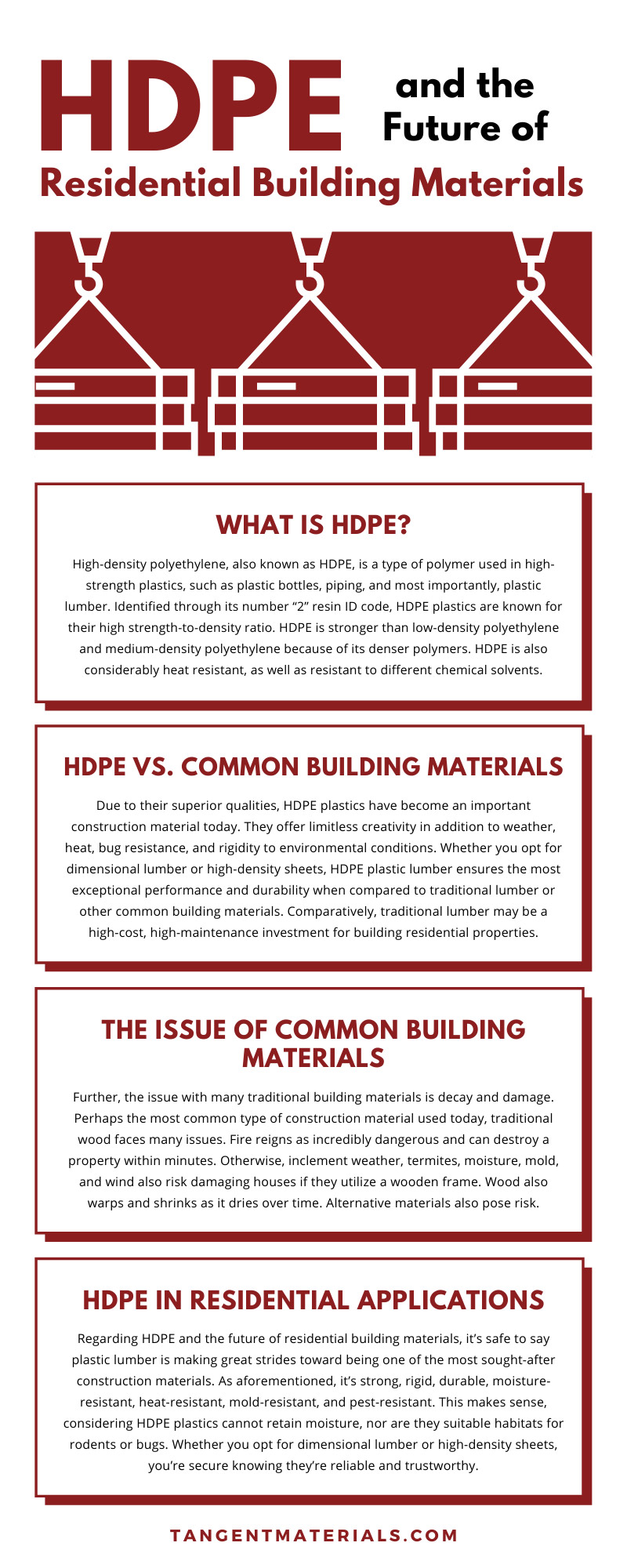HDPE and the Future of Residential Building Materials

There are a few residential building materials commonly used today. Traditional lumber reigns supreme due to its lower cost and easy accessibility. Brick, concrete, steel, and stone are also common building materials that provide greater strength and durability but lack the versatility and aesthetics of wood. Still, there is another option gaining traction as an affordable, sustainable and equally powerful building material for residential properties: HDPE plastic lumber. Since it’s relatively newer as a construction material, not many people understand the versatility and readiness plastic lumber offers over traditional lumber. Read this quick guide on HDPE and the future of residential building materials to learn how plastic lumber stands out above the rest. With exceptional strength, rigidity and heat, moisture, and mold resistance, plastic lumber shines as one of the most sought-after building materials for houses across the country.
What Is HDPE?
High-density polyethylene, also known as HDPE, is a type of polymer used in high-strength plastics, such as plastic bottles, piping, and most importantly, plastic lumber. Identified through its number “2” resin ID code, HDPE plastics are known for their high strength-to-density ratio. HDPE is stronger than low-density polyethylene and medium-density polyethylene because of its denser polymers. HDPE is also considerably heat resistant, as well as resistant to different chemical solvents. Unlike wood-plastic composites, recycled plastic lumber (RPL) is made from 100% recycled plastic materials, making it an environmentally friendly building material.
HDPE vs. Common Building Materials
Due to their superior qualities, HDPE plastics have become an important construction material today. They offer limitless creativity in addition to weather, heat, bug resistance, and rigidity to environmental conditions. Whether you opt for dimensional lumber or high-density sheets, HDPE plastic lumber ensures the most exceptional performance and durability when compared to traditional lumber or other common building materials. Comparatively, traditional lumber may be a high-cost, high-maintenance investment for building residential properties. Even alternatives like cement, steel, bamboo, clay, compact earth or brick don’t compare to the versatility, composition, or customization that HDPE plastic lumber ensures.
The Issue of Common Building Materials
Further, the issue with many traditional building materials is decay and damage. Perhaps the most common type of construction material used today, traditional wood faces many issues. Fire reigns as incredibly dangerous and can destroy a property within minutes. Otherwise, inclement weather, termites, moisture, mold, and wind also risk damaging houses if they utilize a wooden frame. Wood also warps and shrinks as it dries over time. Alternative materials also pose risk. Cement, brick, natural earth, and bamboo are all susceptible to similar hazards like fire, weather and moisture. While steel is one of the strongest materials used in construction, it’s costly, rusts, and doesn’t allow for the same customization in a residential property. Plastic lumber circumvents all these issues.
HDPE in Residential Applications
Regarding HDPE and the future of residential building materials, it’s safe to say plastic lumber is making great strides toward being one of the most sought-after construction materials. As aforementioned, it’s strong, rigid, durable, moisture-resistant, heat-resistant, mold-resistant, and pest-resistant. This makes sense, considering HDPE plastics cannot retain moisture, nor are they suitable habitats for rodents or bugs. Whether you opt for dimensional lumber or high-density sheets, you’re secure knowing they’re reliable and trustworthy. Not to mention, with many different colors, textures, and sizes for your project, there’s endless customization. More so, HDPE plastics are considered a sustainable building material given their makeup of recycled plastic items. These items were recycled and repurposed into plastic lumber with extra polymers for strength and durability. Since it’s resistant to cracks and splitting, HDPE plastic lumber is still replicated to look and feel like traditional lumber. This means construction companies still retain a traditional wooden aesthetic without falling victim to the issues from it. There is no wood-rot or water damage, thus making plastic lumber an exceptional material for outdoor marinas and docks if you live near a body of water. Conditionally, builders may also choose their desired dimensions, colors, and profiles for their needs. Given this wide customization, contractors don’t need to stress over customization or replacement if faced with that situation.
Given the above, you may be wondering what exactly to use your HDPE plastic lumber for. You have countless options to consider. Plastic lumber is a great option for outdoor decks and siding since it can easily withstand weather and temperature changes. Otherwise, consider using it as your houses’ frame. Industrial strength reinforced plastic lumber is long-lasting, so you won’t need to worry about foundational issues. Other considerations include flooring, railings, fences, landscaping, cladding, molding and trim, window and door frames, cribbing, and garden furniture. There are endless possibilities for builders to choose from with HDPE plastic lumber.
Considerations for Builders
Of course, there are some considerations to keep in mind when using HDPE plastic lumber in residential and commercial properties. Load-bearing structures require specific standards to support your house. Also, while heat-resistant, fires and extreme temperatures deform plastic lumber. Plastic lumber does creep in the same way as traditional wood too. Although its viscoelastic nature makes it stronger than wood, HDPE still creeps under intense weight over long periods of time. These are just some things contractors must keep in mind when using plastic lumber as their main construction material for their projects.
Even still, there’s no denying that HDPE plastic lumber is an exceptional building material. It triumphs over traditional lumber and other common building materials due to its incredible strength, rigidity, and durability. When looking for HDPE plastic lumber for your house, choose Tangent Materials. Tangent is the leading distributor of plastic lumber for residential and commercial purposes. Browse our selection of high-density polyethylene sheets or dimensional lumber to find the right one for your project. Then, choose the profile, dimensions, finish, and color. You’ll see we have a plethora of dimensions, colors, and styles available for any application. Call us with any questions or concerns, and we’ll be more than happy to help. Even better, if your plastic lumber warps or doesn’t fit your dimensions, send it back. We’ll take care of it and send you replacements that better serve your needs.













